Vermont is famous for its excellent skiing, maple syrup, and rich history. The Green Mountain State also boasts beautiful scenery, from gorgeous mountains to swampy wetlands. The state is home to many different plants and animals ranging from loons to the state’s official animal, the Morgan horse. Vermont also houses more than its fair share of spiders. From fishing spiders to orb weavers, you can find all sorts of spiders in Vermont. Here is a list of 10 spiders in Vermont that make their home in the Green Mountain State.
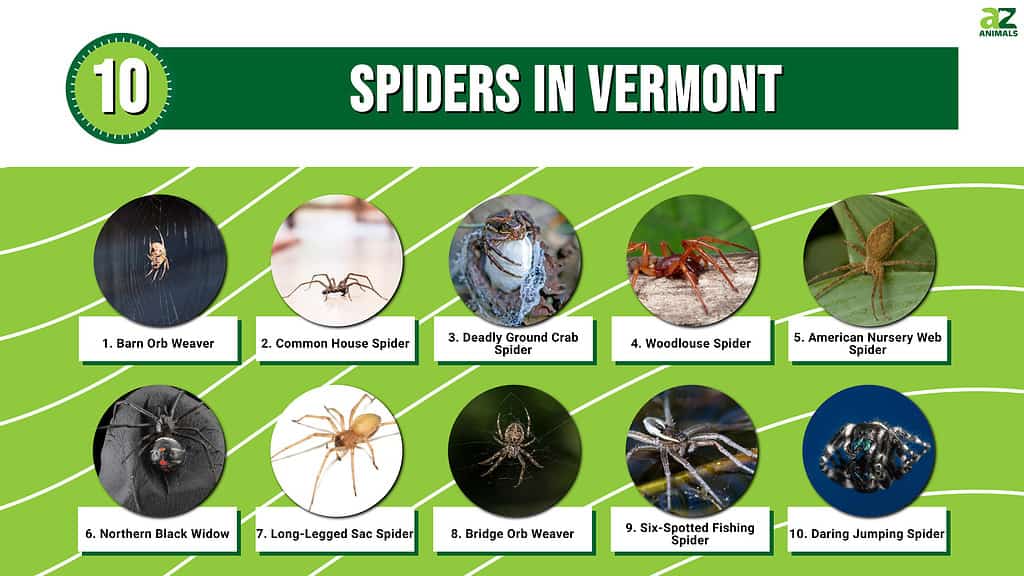
10. Daring Jumping Spider

The daring jumping spider is a large species of jumping spider found in Vermont, but it rarely bites humans.
©iStock.com/JWJarrett
The daring jumping spider, Phidippus audax, belongs to the jumping spider family Salticidae. It also goes by the names “the bold jumping spider” or “bold jumper.” You can find it throughout most of North America.
They look predominantly black, although they do feature an assortment of colored markings on the abdomen. These markings range in color from blue to red to yellow. Like other jumping spiders, they possess large, colorful chelicerae (mouthparts) that often appear metallic blue-green.
Daring jumping spiders rank as one of the most athletic spiders in Vermont. They can jump nearly 50 times their body length, hence their name, bold jumpers. Their keen eyesight augments their jumping ability when hunting for food. Despite their proficiency as hunters, they thankfully pose no danger to humans due to their small size.
9. Six-Spotted Fishing Spider
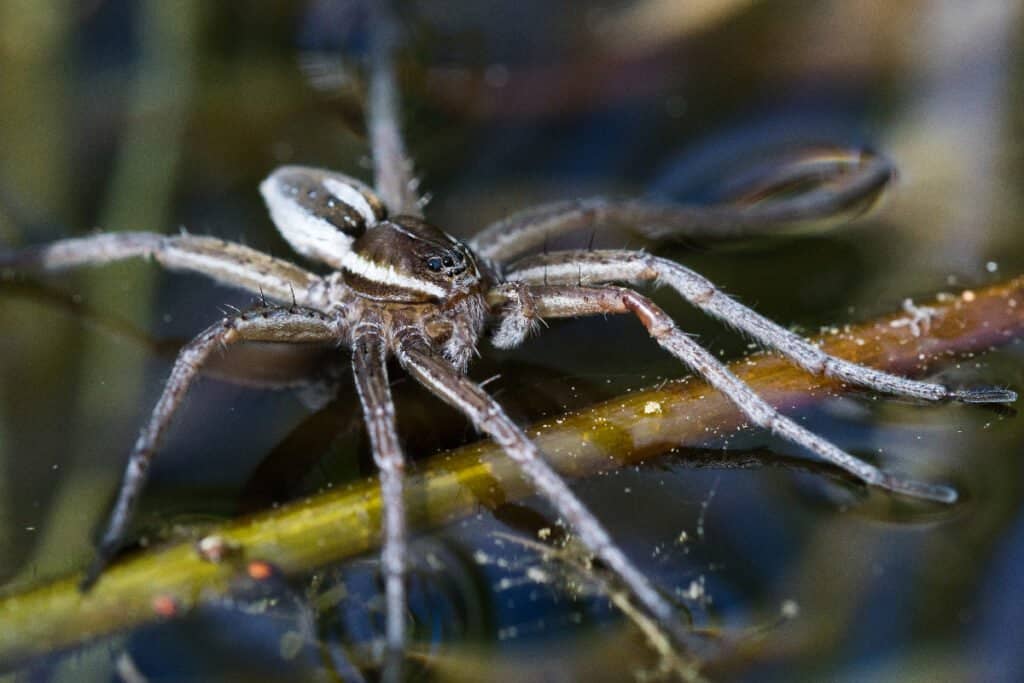
The six-spotted fishing spider can catch fish more than five times its own size.
©Jukka Jantunen/Shutterstock.com
Dolomedes triton, or the six-spotted fishing spider, is a member of the nursery web spider family Pisauridae. You can find these semi-aquatic spiders in Vermont and throughout much of North America.
Adult females range from 15 to 20 millimeters long, while males measure between 9 and 13 millimeters long. They look mostly grey or brown aside from a creamish-white stripe down each side of the body. The ventral side of the abdomen sports numerous light spots. Meanwhile, the dorsal side features 6 distinctive dark spots, which is where they get their name.
Six-spotted fishing spiders do not use webs to catch prey. As their name implies, they hunt by using their legs as fishing lures to snatch insects and small fish from the water. Occasionally, they will run across the surface of the water or dive under its surface to find food.
8. Bridge Orb Weaver

The bridge orb weaver often builds its web on bridges or other metal structures.
©Paul Reeves Photography/Shutterstock.com
The bridge orb weaver, Larinioides sclopetarius, belongs to the orb weaver family Araneidae. It ranges throughout much of the eastern, southern, and northwestern United States. You can also find it in Mexico, Canada, Europe, and parts of Asia.
Adult females measure from 10 to 14 millimeters long and males measure 8 to 9 millimeters long. The body appears predominantly grey while the legs feature alternating white and tan bands. Additionally, they feature a light grey cross-shaped marking on top of the abdomen. This marking is the reason why some people call them grey cross spiders.
If you want to find these spiders in Vermont, your best bet is to look around bridges. That’s because they often make their webs on manmade metal structures such as bridges, hence their name. Their webs can reach nearly two feet wide and are designed to trap prey.
7. Long-Legged Sac Spider
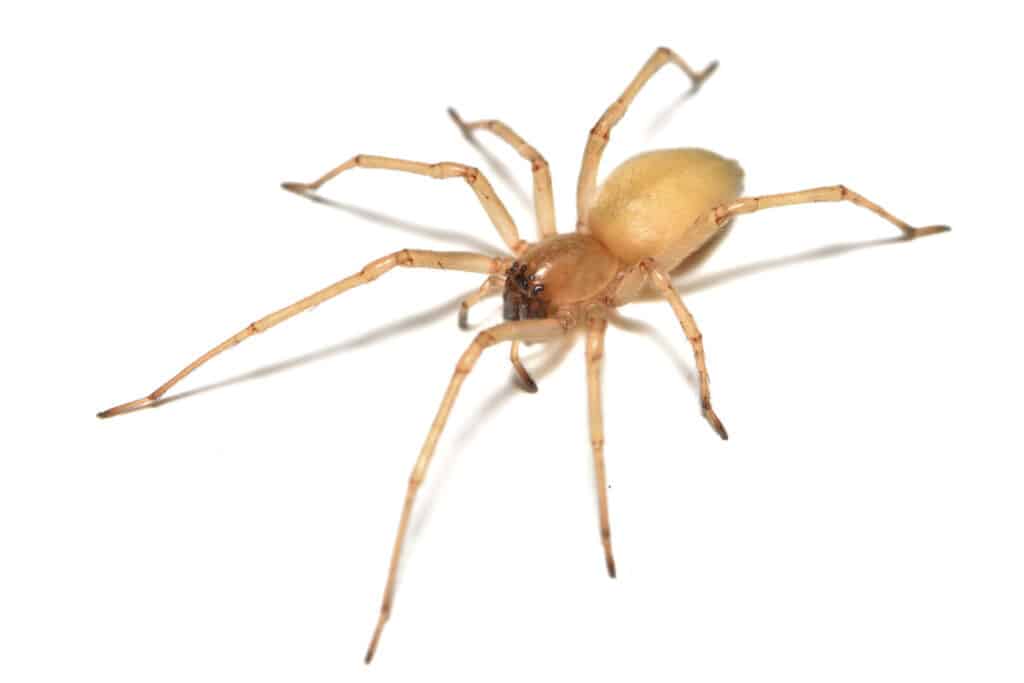
The long-legged sac spider builds a silk sac to hide from predators.
©Tobias Hauke/Shutterstock.com
Cheiracanthium mildei, or the long-legged sac spider, is a member of the prowling spider family Miturgidae. It also goes by the name the northern yellow sac spider. You can find these spiders in Vermont as well throughout much of North America.
Adult long-legged sac spiders normally measure 5 to 9 millimeters long, with males usually measuring smaller than females. They range in color from white to pale green or yellow or light brown. However, the abdomen is almost always a lighter shade than the cephalothorax. Their legs are noticeably long and thin, which is where they get their name.
Long-legged sac spiders do not use webs to capture prey. However, they do build silk shelters that they hide in during the day to avoid predators. They normally use ambush tactics when hunting but will also readily chase down slower insects. Their bite is not dangerous but can be mildly painful.
6. Northern Black Widow
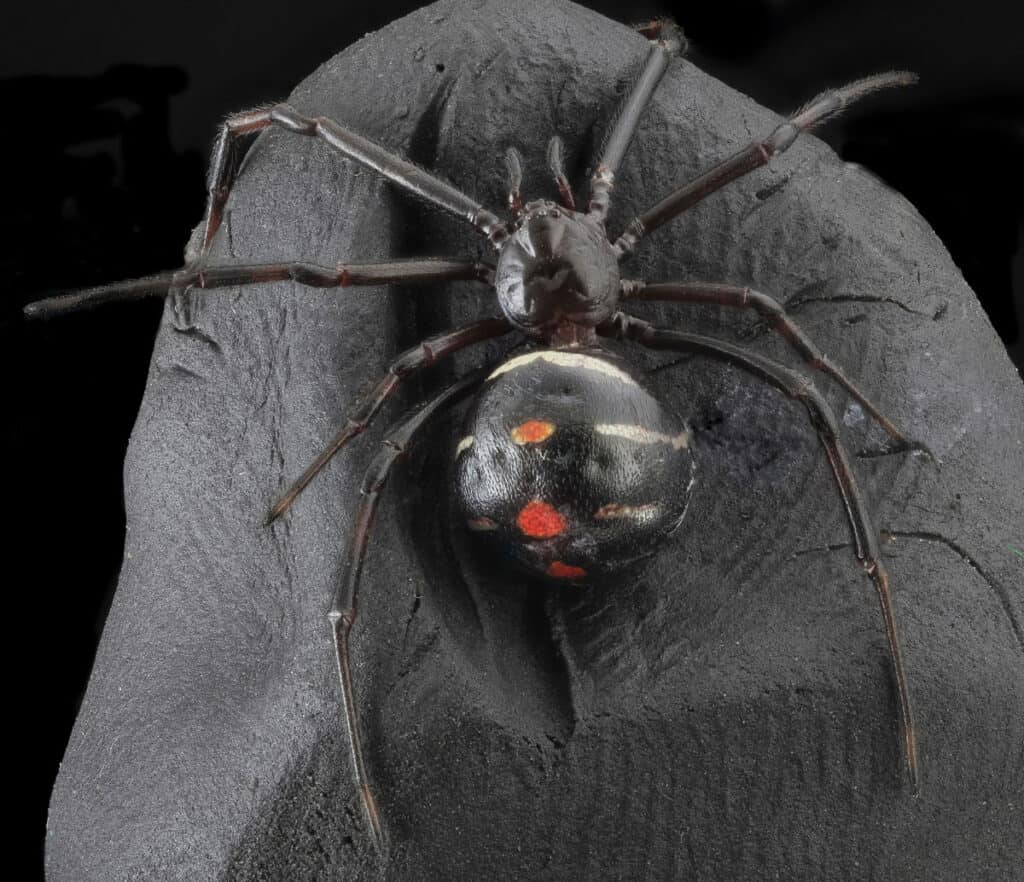
Several people are hospitalized each year due to bites from northern black widow spiders.
©Porco_Rosso/Shutterstock.com
The northern black widow, Latrodectus variolus, is one of the most venomous spiders in Vermont. A member of the cobweb spider family Theridiidae, you can find it throughout the northern United States and Canada.
Female northern black widows measure 9 and 11 millimeters long and males measure 4 to 5 millimeters long. They look almost entirely black except for a small red hourglass-shaped marking on the abdomen. Unlike other black widows, this hourglass-shaped marking normally appears broken, which can help you tell it apart from other widows.
Northern black widows build tangled cobwebs that they use to capture their prey. Their venom carries a neurotoxin capable of causing latrodectism. Symptoms commonly associated with their bite include pain, sweating, vomiting, and muscle rigidity. While normally not dangerous, more serious complications can arise, especially for very young or immunocompromised people.
5. American Nursery Web Spider
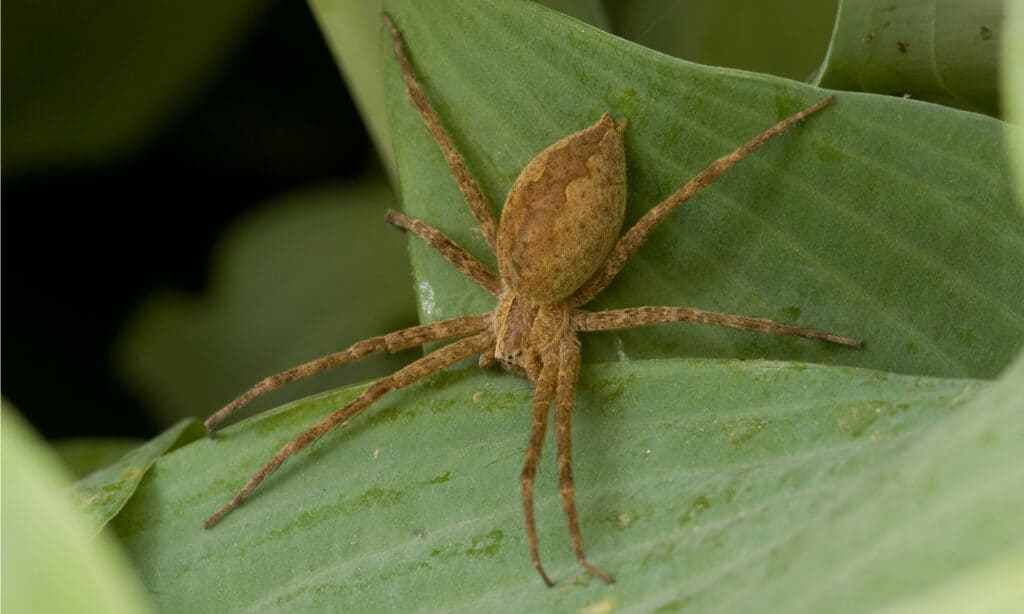
Male American nursery web spiders will tie females’ legs during mating to avoid being eaten afterward.
©SDeming/Shutterstock.com
Pisaurina mira, or the American nursery web spider, is the second member of the family Pisauridae to make our list of spiders in Vermont. It ranges throughout the eastern United States and North America at large, hence its name.
Adult females can measure up to 19 millimeters long. Meanwhile, males typically measure significantly shorter, but possess longer legs. The abdomen is almost twice the length of the carapace. They look predominantly brown or tan except for their abdominal markings. These markings vary but typically consist of either a dark band or a light band bordered by rows of spots.
American nursery web spiders are sit-and-wait predators that prefer to ambush their prey. Females spin webs, but only to hold their eggs. On the other hand, males use their silk to tie up the females during mating. They do this to avoid being eaten, as the females are notorious cannibals.
4. Woodlouse Spider

Woodlouse spiders evolved their large chelicerae to better help them hunt their preferred food woodlice.
©K Hanley CHDPhoto/Shutterstock.com
The woodlouse spider, Dysdera crocata, is a member of the family Dysderidae. You may know it by one of several names, including the pillbug hunter, sowbug killer, or cell spider. It is one of the more common spiders in Vermont and ranges throughout much of the world.
Adult females typically measure from 11 to 15 millimeters long and males measure 9 to 10 millimeters long. The carapace and legs appear predominantly orangish-red, while the abdomen looks grey or yellowish-brown. Additionally, they have only six instead of eight eyes, unlike more spiders. Lastly, they possess disproportionately large chelicerae (mouthparts).
Woodlouse spiders evolved their large chelicerae to better help them hunt woodlice, their favored food. Their powerful bite makes it easy for them to pierce through the tough exoskeletons of woodlice, hence their name. Their powerful jaws pose no threat to humans but can deliver a painful bite.
3. Deadly Ground Crab Spider

The deadly ground crab spider is not as deadly as it sounds.
©WanderingMogwai / Creative Commons – License
Xysticus funestus, or the deadly ground crab spider, belongs to the crab spider family Thomisidae. You can find these spiders in Vermont as well throughout much of the United States, Mexico, and Canada.
Female deadly ground crab spiders usually measure around 10 millimeters long. On the other hand, males only measure about half that size. They tend to look primarily orange-colored aside from some dark markings on the abdomen. Like other crab spiders, they possess long, curved legs and can walk forward, sideways, and backward like a crab.
Deadly ground crab spiders don’t use webs to catch their prey. Instead, they take advantage of their long legs which they use to grab prey that wander too close. Although they sound quite intimidating due to their name, in reality, they pose little threat to humans. At worst, their bite causes only mild pain and swelling that subsides after a few days.
2. Common House Spider
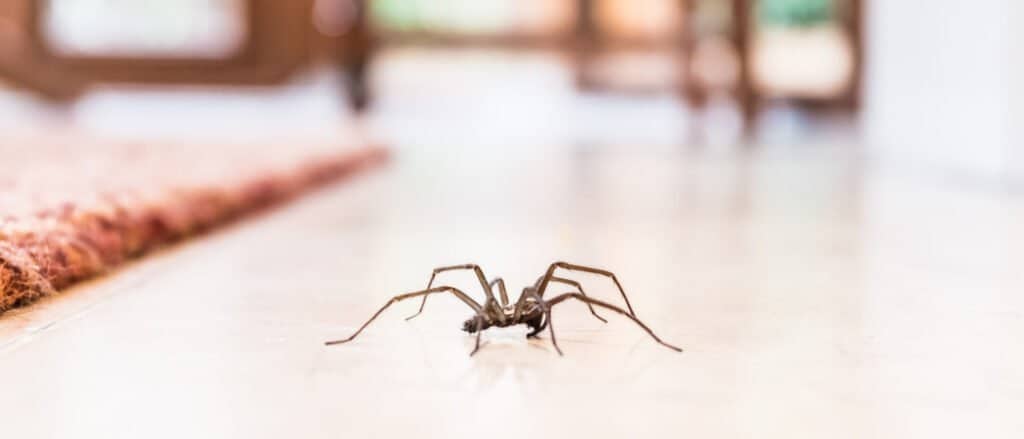
People can mistake common house spiders for widow spiders due to their similar appearance.
©Christine Bird/Shutterstock.com
Parasteatoda tepidariorum is more well-known as the common house spider. It’s part of the Theridiidae family and one of the most ubiquitous spiders in Vermont. It’s often found in or near human dwellings, hence its name.
Female common house spiders generally measure between 5 and 6 millimeters long and males measure 4 to 5 millimeters long. They range in color from black to tan and sport an assortment of different markings on the abdomen. Occasionally, people mistake them for widow spiders due to their similar appearance.
Common house spiders make irregularly-shaped cobwebs that they use to catch prey. By sensing vibrations they can detect when insects enter their web. They then move in and paralyze their prey with a venomous bite. While dangerous to insects, their bite is not threatening to humans.
1. Barn Orb Weaver

Barn orb weaver spiders spin flat, spiral-shaped webs and get their name from their habit of living in barns and wooden structures.
©Ken Beard/Shutterstock.com
The barn orb weaver, Araneus cavaticus, is the second member of the family Araneidae to make our list of spiders in Vermont. Also known simply as the barn spider, it gets its name from its habit of living in barns and other wooden structures. You can find it throughout the northeastern United States and Canada.
Adult females typically measure 12 to 16 millimeters long, while males measure 6 to 10 millimeters long. They appear mostly yellow or brown and sport dark stripes on their legs. The bottom half of the body looks most black aside from some white markings. Small hairs cover the entire body, and the abdomen features several small bumps.
Barn orb weaver spiders spin flat, spiral-shaped webs made of sticky threads that they use to capture prey. Their bite is not medically significant but can cause some swelling and redness.
Summary of 10 Spiders in Vermont
Here’s a recap of the 10 spider species present in Vermont that we took a look at.
| Number | Spider | Scientific Name | Length |
|---|---|---|---|
| 1 | Barn Orb Weaver | Araneus cavaticus | Females: 12-16 mm; males: 6-10 mm |
| 2 | Common House Spider | Parasteatoda tepidariorum | Females: 5-6 mm; males: 4-5 mm |
| 3 | Deadly Ground Crab Spider | Xysticus funestus | Females: 10 mm; males are about half that size |
| 4 | Woodlouse Spider | Dysdera crocata | Females: 11-15 mm; males: 9-10 mm |
| 5 | American Nursery Web Spider | Pisaurina mira | Females: 19 mm; males are significantly shorter but have longer legs |
| 6 | Northern Black Widow | Latrodectus variolus | Females: 9-11 mm; males: 4-5 mm |
| 7 | Long-Legged Sac Spider | Cheiracanthium mildei | 5-9 mm; males are usually smaller |
| 8 | Bridge Orb Weaver | Larinioides sclopetarius | Females: 10-14 mm; males: 8-9 mm |
| 9 | Six-Spotted Fishing Spider | Dolomedes triton | Females: 15-20 mm; males: 9-13 mm |
| 10 | Daring Jumping Spider | Phidippus audax | Females: 11 mm; males: 8 mm |
The photo featured at the top of this post is © Sample Stars/Shutterstock.com
Thank you for reading! Have some feedback for us? Contact the AZ Animals editorial team.






